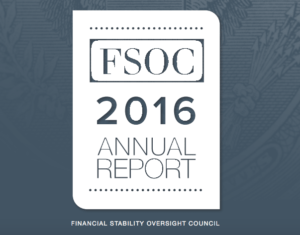
Blockchain Tech ‘Pose Certain Risks And Uncertainties,’ Say US Regulators
by Fintech News Singapore October 13, 2016Although blockchain technology could help improve efficiency and reduce risks associated with trading, clearing, settlement, and custody services, distributed ledger systems “pose certain risks and uncertainties” which market participants and regulators need to monitor, according to a group of US regulators.
 In its annual report released in July, the Financial Stability Oversight Council – a group that includes the US Treasury department, the Federal Reserve and the Securities and Exchange Commission -, warns that the growing popularity of bitcoin and other digital currencies is posing risks to the financial stability.
In its annual report released in July, the Financial Stability Oversight Council – a group that includes the US Treasury department, the Federal Reserve and the Securities and Exchange Commission -, warns that the growing popularity of bitcoin and other digital currencies is posing risks to the financial stability.
The report notes that in recent months, bitcoin trade confirmation delays have increased dramatically and some trade failures have occurred. This happens when the speed with which new bitcoin transactions are submitted exceeds the speed with which they can be added to the blockchain.
The document points out that “although distributed are designed to prevent reporting errors or fraud by a single party, some systems may be vulnerable to fraud executed through collusion among a significant fraction of participants in the system.”
Since blockchain technology is still at a very early stage of development, “market participants have limited experience working with distributed ledger systems.”
“It is possible that operational vulnerabilities associated with such systems may not become apparent until they are deployed at scale,” the report says.
Financial innovations offer opportunities to lower transaction costs and improve efficiency of financial intermediation. However, new financial products, delivery mechanisms, and business models “may also embed risks, such as credit risk associated with the use of new and untested underwriting models.”
Innovations such as distributed ledger systems and online marketplace lending “merit special attention from financial regulators who must be vigilant to ensure that new products and practices do not blunt the effectiveness of existing regulations or pose unanticipated risks to markets or institutions.”
Online marketplace lending refers to the practice of using investment capital and data-driven online platforms featuring algorithmic underwriting models to lend either directly or indirectly to consumers and small businesses. As the trend continues to grow, financial regulators need “to be attentive to signs of erosion in lending standards.”
Overall, regulators need to continue to remain vigilant in monitoring new and rapidly growing financial products and business practices, “even if those products and practices are relatively nascent and may not constitute a current risk to financial stability,” the report says.
Echoing the warning, Australia’s “Big Four” banks ANZ and Westpac have remained about the risk of developing and implementing blockchain technology in the domestic financial system.
Speaking at the 2016 Blockchain Summit in September, Nicholas Groves, strategy executive at ANZ said:
“We spend a lot of time reading and learning about blockchain. There are concerns within the banks that we may be exposing ourselves to risks we don’t understand. We need to be conscious of what we are building. We need to understand the data.”
Westpac’s director of payments Michael Southwell said that it was critical for banks to remain cautious when introducing new technologies to “systemically important payment systems.”
Earlier this year, the UK government chief scientific adviser Sir Mark Walport released a report addressing how blockchain technology can revolutionize services both in government and the private sector.
The document, titled ‘Distributed ledger technology: beyond block chain,’ advises:
“Successful implementation of a distributed ledger will require a combination of governance to protect the participants and stakeholders and regulation to ensure the system is resilient to systemic risk or criminal activity.
“The challenge is to strike the balance between safeguarding the interests of participants in the system and the broader interests of society whilst avoiding the stifling of innovation by excessively rigid structures.”
Featured image: Bitcoin by Julia Tsokur, via Shutterstock.com.







